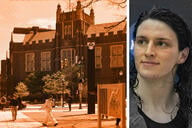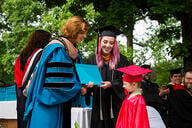You have /5 articles left.
Sign up for a free account or log in.
The horror stories of so-called helicopter parents are well-known among college admissions administrators and orientation directors. Moms and dads who cling to their young adult children, follow them around during orientation programs and call them constantly from home are ubiquitous on college campuses around this time of year as incoming first-year students take part in programs designed to help them get acclimated.
Joyce Holl, executive director of NODA, the Association for Orientation, Transition and Retention in Higher Education, has seen it all.
She recalled the mother who channeled her inner James Bond and surveyed her offspring while hiding behind the bushes during orientation, clandestinely stalking the freshman until she was caught.
Fortunately for mortified students and exasperated orientation staff, the gas is being taken out of the engines of many helicopter parents. Orientation programs designed to assuage nervous parents' fears and inform them about the institutions their children have chosen to attend are becoming more common, Holl said. More importantly, they're helping make the process smoother for all concerned -- and reducing the separation anxiety experienced by overprotective parents.
Now, as new students go through orientation, their parents go through their own orientation programs, too.
"Our institutions are doing good job of helping both parents and their students acclimate," Holl said.
Some parents still have trouble letting go, however, Holl said. And some parents feel they shouldn't have to, especially since they're bankrolling their children's education. With college tuition and fees skyrocketing across the board -- and particularly at four-year institutions, where these parent orientations are mostly held -- some parents want to make sure they're getting their money's worth.
At Murray State University, a regional public institution in Kentucky with an enrollment of about 10,000 students, parents often ask during orientation about career opportunities once students graduate, said Shawn Smee, director of the university’s student recruitment office. They want to know how often students go on to enroll in graduate school or if they’re finding jobs easily, he said. Murray State has hosted a parent orientation program since the late 1980s after launching its student orientation program in the 1970s, he said.
About 1,800 first-year and transfer students took part in orientation at Murray State in the last academic year. Smee said he's seen an influx of helicopter parents in the last few years. As a result, the university set up a panel of parents of current students to answer questions and provide helpful information to the parents of incoming freshmen. But worried parents will still show up for orientation, sometimes even without their children, and want to go through the orientation process for them.
“We say, ‘This is great, but we have to see the student,’” he said.
Parents tend to fret most about campus safety issues. Reports of sexual assaults are often far more visible than when the parents attended college. They also worry about binge and underage drinking on campus. Orientation program staff spend a lot of their time addressing such concerns, Holl said. They not only tell parents about the police presence on campus, they also tell them how to access resources, such as financial aid, for their children.
“Anecdotally, it’s really helped bridge the gap with what's happening with that student and parents letting go, especially if it’s their first one,” Holl said.
Orientation has been a staple on college campuses for decades. NODA, once named the National Orientation Directors Association, was chartered in 1976. Orientation programs that once lasted a few weeks now can sometimes go on for months, Holl said. And institutions are also now promoting orientation for transfer students and, in some cases, for sophomores as well. A second year of orientation helps retain these students, Holl said.
Colleges began offering orientation for parents in the 1990s, but the trend exploded in the last several years, Holl said. About 83 percent of institutions have some sort of parent, family or guest orientation program, according to a 2017 survey NODA conducted of 229 campuses. About 21 percent of the institutions said they communicate with students and their families in face-to-face workshops.
The parent orientations tend to last a half or full day, but occasionally universities will offer up a dormitory for parents to spend the night in. James Madison University, in Virginia, was allowing parents to do sleepovers on campus as early as 1995, according to The New York Times.
Orientation has become part of colleges’ curbside appeal, which is particularly important in college selection. Parents whose children still have not decided which college they will attend will on rare occasions go to orientations at multiple institutions and urge their children to select a college based on the orientation program.
“It’s mind-boggling,” Holl said.
The University of Minnesota, Twin Cities, has a robust orientation program and has sponsored a session for parents since at least 1999, said Lisa Gruszka, the director of orientation programs.
Minnesota offers a nearly two-day orientation program for students that allows parental participation on one of the days. Because so many parents drive from the outskirts of the largely rural state, or from Wisconsin or Iowa, the university offers them overnight housing either in a residence hall or at a local hotel, Gruszka said. The college also arranges a trolley ride around campus for students and parents; students can get discounts at local restaurants with university identification.
The parents’ orientation lasts almost a full day, from the early morning until about 5:30 p.m. University administrators decided to shift the program in 2003 to loosely mimic Maslow's hierarchy of needs, a psychological theory. Officials first address student health, finances and safety and work their way up to other university programs, Gruszka said. The university worked with a little more than 6,000 students over two days of orientation last academic year.
Students and parents are required to be apart for most of this presentation, Gruszka said. They may jointly, but briefly, attend a session about academic standards, but for the most part, university administrators want the students to start feeling a “sense of belonging,” she said.
The orientation officials want to coach and be partners with parents, Gruszka said. They would prefer parents not call the university if their children have questions and not otherwise be overly involved in running their children's lives on campus.
Students talk to their parents a lot more now than they did several decades ago, Gruszka said. When she attended college in the 1980s, she called her family maybe once a week with a long-distance calling card. Now, parents are a text away for all of their children’s needs.
“We want to make sure our families understand the basic business but not have their children feel the need to call home or call home multiple times a day,” she said.
These programs are often successful at alleviating the worries of anxious parents, said Roger H. Martin, former president of Randolph-Macon College in Virginia. He wrote Off to College: A Guide for Parents (University of Chicago Press), a book about students’ first time separating from parents and how families should handle the transition.
College administrators often discourage students from going home every weekend or when they’re homesick, and they ask parents to reinforce that guidance, Martin said. Holl said NODA tells member institutions that students shouldn’t visit home at all in the first month.
This “helps them see the need for their children to be independent,” Martin said. “Part of college is learning how to become an adult, and if you’re constantly calling your kid up or trying to do things for them, that doesn’t happen.”




